
|
|

September 17, 2010
Yuma, Arizona, 2009 (Part II)
As this week's installment of Site of the Week goes up, it's a chilly, rainy September in our home base of western New York, reminiscent of the cool, damp weather that marked the start of the summer of 2009 here.
After a few weeks of that kind of weather, we began craving some real summer - and somehow, that ended up translating into an unusual summer vacation indeed: a couple of days in Yuma, Arizona in early August. Maybe you just had to be in Rochester that soggy June and July, but by the time we headed west, the idea of 110 degree weather with zero humidity and no clouds in the sky began to seem far more appealing than it might appear in retrospect. (Yuma, it should be noted, boasts the sunniest weather of any city in the U.S.)
And yes, there were broadcast-related considerations, too: we'd missed out on airchecking a few of the stations in town during the brief April swing through Yuma chronicled last week in this space, and we hadn't made it inside any of Yuma's stations for tours.
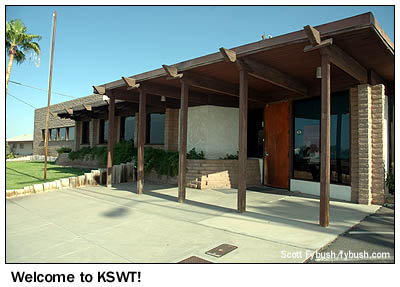 |
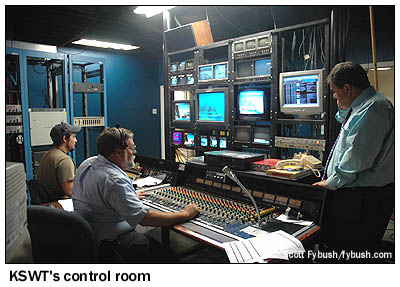 |
And so it came to pass that we flew to San Diego, rented a car, and set out on I-8 eastbound for the three-hour drive into the desert - and a few hours later found ourselves inside the oldest TV facility in Yuma, the studio of CBS affiliate KSWT (Channel 13). As we chronicled last week, this building was originally built for the first TV station in town, KIVA-TV (Channel 11), but after KIVA went belly-up in 1971, channel 13 (then known as KBLU-TV) moved a block west into this space, and has been here ever since.
We arrived, as it happened, on one of the busier news days Yuma had seen for a while: a chemical plant on the east side of town had just gone up in flames, forcing the evacuation of several neighborhoods. KSWT normally starts its afternoon newscast at 4, but it was on the air even earlier with special reports, taking advantage of having the only live truck in town. The station even pre-empted the CBS Evening News to keep covering the situation.
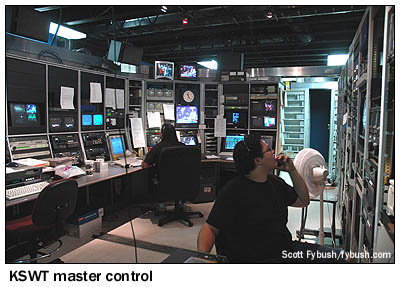 |
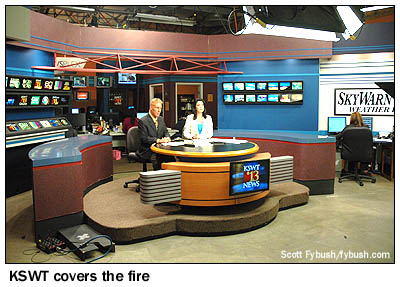 |
As the pictures here should indicate, such a small-market operation pulls off a feat like this, by necessity, with a very limited staff and fairly basic facilities. KSWT's building is arranged in an L-shape: from the lobby, a corridor leads off to the left past sales and traffic offices, then bends to enter an open-plan technical core that combines tape library, master control and production control in one big area adjacent to the studio/newsroom. (Or, if you prefer, the "KSWT 13 Newsplex"!)
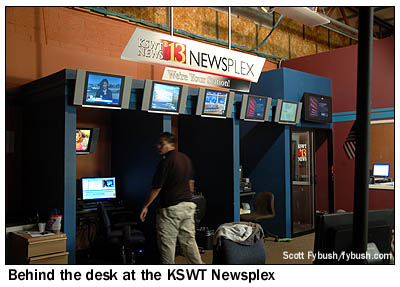 |
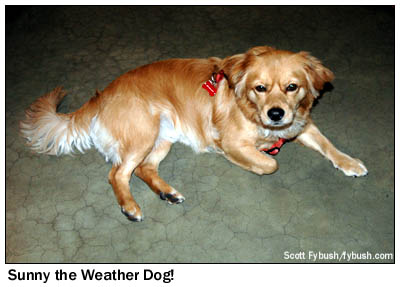 |
There's nothing fancy - just functional - in the Newsplex: a line of edit bays next to the news director's office, a cluster of desks for reporters and anchors in the middle, and the news set and weather area in front. And we can't forget Sunny the Weather Dog, who makes appearances on the air and at area schools and community functions while doubling as the news director's pet!
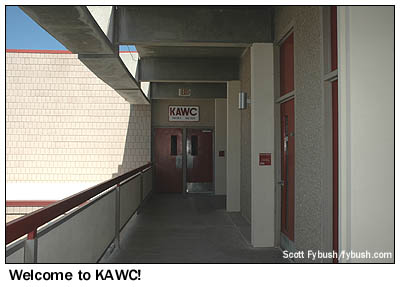 |
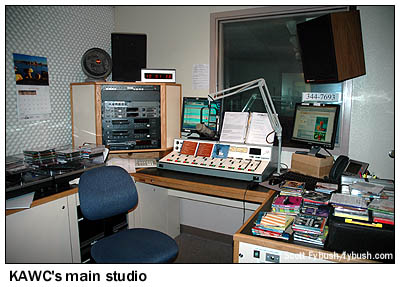 |
Ever since your editor began working in the world of public radio, we've especially enjoyed making the acquaintance of fellow public broadcasters and seeing their facilities - and we couldn't pass up the chance to see one of the more remote public radio outposts in the country on this trip: KAWC (1320) and KAWC-FM (88.9) at Arizona Western College, on the eastern outskirts of Yuma (and, as it happens, in the evacuation zone from that fire, which meant our visit had to wait until the next morning, when things had settled down and Yuma had returned to its normal state of calm.)
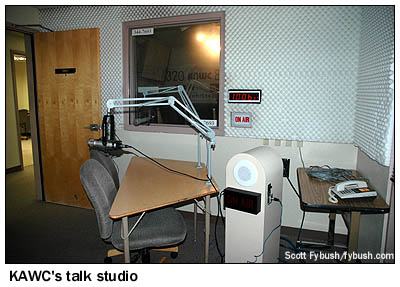 |
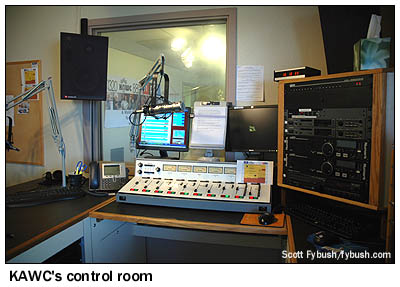 |
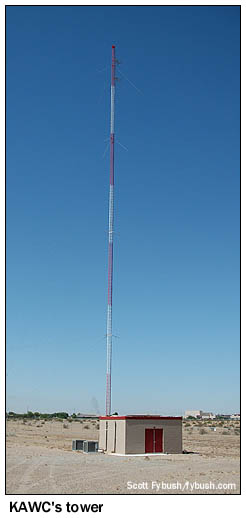 In
last week's chronicling of Yuma radio history, we sketched the
broad outlines of this station's history: it was born from the
1969 merger of Eller Telecasting, which owned KBLU-TV (Channel
13) and KBLU (1320), into Combined Communications, which owned
KYUM (560).
In
last week's chronicling of Yuma radio history, we sketched the
broad outlines of this station's history: it was born from the
1969 merger of Eller Telecasting, which owned KBLU-TV (Channel
13) and KBLU (1320), into Combined Communications, which owned
KYUM (560).
The merger sent the KBLU calls and programming down the dial to the superior 560 facility, and under the "one-to-a-market" rules in effect at the time, it meant Combined had to unload its other AM signal in the market on 1320. Rather than create a commercial competitor in that very small market, Combined donated the 1320 facility to Arizona Western College, which returned it to the air in July 1970 as KAWC, a 500-watt daytimer.
For the next two decades, that little AM signal was the entirety of public radio service to Yuma; it wasn't until 1992 that AWC added FM service via KAWC-FM (88.9), also operating from the AM tower on the edge of AWC's sprawling campus not far from I-8.
When we visited in the summer of 2009, the stations were about to go through some major programming changes, replacing the eclectic mix of NPR news/talk and music on both signals with a more focused NPR lineup on KAWC-FM and an even more eclectic blend of AAA music, jazz and some news from PRI and the BBC on the AM station. (That AM program lineup is now largely duplicated a few hours to the north on KJZA/KJZK/KJZP, a network of small FM signals and translators covering Prescott and the I-40 corridor in northern Arizona from Kingman to Flagstaff.)
KAWC's facilities on the second floor of one of the AWC academic buildings are simple but functional: along one side of a long hallway, there are studios for the music and news programming (they do indeed use those turntables in the music studio!) and a talk studio for KAWC's local public affairs programming. Across the hall are production studios and a sizable music library.
And with limited resources, KAWC prides itself on homebrew technical innovation. That's not a model of R2-D2 perched next to the desk in the talk studio; it's a homemade movable turret that allows audio connections to be moved from room to room within the studio complex.
Out at the transmitter site at the western end of the campus, everything's fairly new outside thanks to a 2006 renovation that brought a new transmitter enclosure and tower. Inside, there's a new Harris FM transmitter and a fairly modern BE solid-state AM, as well as the older Harris AM transmitter that's used as a backup. These are both relatively low-powered signals - KAWC-FM runs 2.4 kW/108', while KAWC(AM) runs 730 watts by day, 110 watts at night. The FM station has a pending application to move to a higher site east of town as a 1.5 kW/1190' C3 facility, and AWC has pending applications as well to extend its service through new transmitters in outlying communities including Parker, Quartzsite and Wellton.
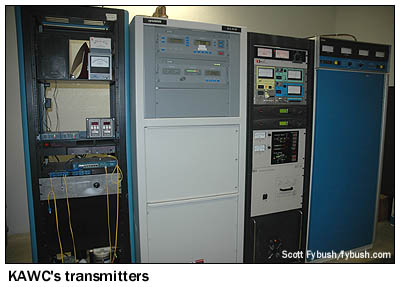 |
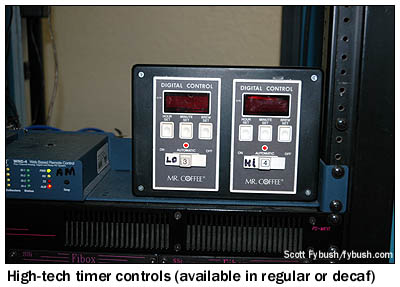 |
Before we leave the transmitter site, there's one more piece of homebrew technology, with an emphasis on "brew," worth noting: the day/night power switching for the AM signal is managed by a pair of timers scavenged from old Mr. Coffee machines - and general manager Dave Riek says they've been just as reliable as any purpose-built timer could be.
In next week's installment, we move west along I-8 to another very hot spot: El Centro, California and the Imperial Valley. In the meantime, we're still taking pre-orders for Tower Site Calendar 2011 (shipment has been slightly delayed by some production glitches, but we're still expecting to be sending out the first calendars by mid-September) - and we'll have lots of Yuma and even San Luis Rio Colorado IDs for you to listen to starting Sept. 22 over at sister site TopHour.com, too!
 - Find out when the new Tower Site is posted,
and much more! Follow us on Twitter @NERadioWatch - and don't miss your chance to pre-order the
all-new Tower Site Calendar 2011 at the Fybush.com
store!
- Find out when the new Tower Site is posted,
and much more! Follow us on Twitter @NERadioWatch - and don't miss your chance to pre-order the
all-new Tower Site Calendar 2011 at the Fybush.com
store!- Previous Site of the Week: Yuma, Arizona, part I
- Next Week: California's Imperial Valley and the Colorado River Valley
- Site of the Week INDEX!
- How can you help support Site of the Week? Click here!
- Submit your suggestions for a future Site of the Week!

